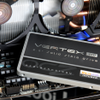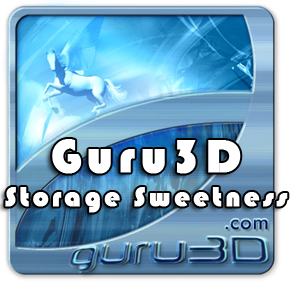Final words and conclusion
Final words and conclusion
I find the Vertex 450 to be an interesting release as OCZ is now moving back and forth with controllers in the Vertex lineup.
- The original Vertex had a JMicron controller
- The Vertex 2 had a Sandforce 1200 series controller
- The Vertex 3 had a Sandforce 2281 series controller
- The Vertex 3 Pro had a Sandforce 2582 series controller
- The Vertex 3.20 Pro had a Sandforce 2281 series controller
- The Vertex 450 has a Indilinx Barefoot 3 M10 controller
You can tell that OCZ is trying to break a cycle alright, they might be ditching LSI (Sandforce) all together. The reason is simple, they have a propyitary controller series in-house that is really fast. And heck, with your own design team, why shouldn't you use your own technology and firmware. If anything that should reduce costs.
Talking about cost reduction, the product comes with 20nm NAND flash memory, and by doing so OCZ can keep the prices much lower. So the reason for this release mainly seems to be cost reduction next to a product refresh of course, which is something the market needs every 6 to 12 months..
Performance
The Vertex 450 is based upon the Indilinx architecture controller, and with it reaching revision 3 (Barefoot 3) it certainly is showing what it can do. The SSD shines at many factors, IOPS performance is really good. This SSD is writing and reading serious amounts of tiny files in a very fast fashion. We stated it before though, IOPS is not something you as a consumer should worry about too much unless you are doing a lot of database related stuff on your PC, but this SSD certainly shows leading performance when it comes to IOPS performance. PCMark Vantage 64-bit was really imrpessive, this is a trace test and can emulate what you guys do on your PC but then multiplied with factor 100. But yes, where the Vertex 450 series are going to shine is it's overall IO and razersharp write performance. Zoom in at both IOPS and Trace performance then you'll notice that the SSD can manage near silly workloads without breaking a sweat. So that's testimony towards the new Barefoot 3 controller.
Overall SSD usage
An SSD is enjoyable, very much so. If you put a drive like this into your SATA 3 compatible laptop or SATA 3 compatible PC, you'll have no idea what is about to hit you. As stated, we very much enjoy the grand overall performance of this SSD series, so when you copy a vast amount of compressed data, then the SSD will perform seriously fast in performance. Make no mistake, replacing a HDD with an SSD in your desktop PC or laptop eliminates the random access lag of the HDD head, it is no longer mechanical. That, combined with the performance SATA3, is simply a massive difference and probably the best upgrade you can make for your computer anno 2013.
SATA Controllers
Some overall recommendations then. Should you be in the market for a SATA 3 SSD then we have a couple of hints; first and foremost if you have a SATA2 controller only on your motherboard, then you'll get limited at roughly 270 MB/sec read and writes. SATA3 (6Gbps) will free you up from that allowing the SSD to perform in the 500 MB/sec range. It however is important that you connect your SSD to the proper controller. We absolutely prefer the performance of the Intel Series 6 and 7 (H67/P67/Z68/Z77/H77/X79/Z87) integrated SATA 6G controller over anything else available in the market. If you run the SSD from a 3rd party controller with say a Marvell 6G controller, you will see lower performance. The new AMD 85X chipsets also offer fantastic performance. The more recent Asmedia controllers we spotted lately on motherboards are also offering good performance, albeit still 20%~25% slower than Intel's controllers. Also make sure you run your drive in AHCI mode, it does make such a difference in performance -- really guys, a big difference.
Prices HDD versus SSD
First, a generic rule that I always apply; you probably should stop looking at the Solid State Disk technology as if it were a traditional HDD. We all will be old and grey before SSDs reach the same prices or top the multiple TB volume storage the HDD offers for less money. Comparing an SSD with an HDD is making a comparison in-between an integrated IGP or a dedicated graphics card, that last one will cost you a heck of a lot more yet you gain incredible overall performance. It is the very same with an SSD, use it as boot drive on Windows and applications and you instantly have removed a huge bottleneck, namely load and access times. It is a difference in-between night and day (in a proper system). For massive storage like movies, MP3 files and bulky data you do not access on a regular basis, sure, that's where the HDD remains the winner as a cheaper storage solution. Guru3D's rule of thumb; the magic simply is finding a good combination in-between the two and to balance things out. Use a nice 240GB SSD for your operating system and applications, and park those movies and MP3 files onto a separate TB HDD. That's where the magic happens. I kid you not, all my test systems and work systems run on SSDs, not once have I considered going back to HDDs. The benefits of a good SSD are simply grand. But that doesn't mean I do not understand the budget and cost dilemma that many of you are facing though.
The SSD is available in three volume sizes: 128GB, 256GB and 512GB are available. Prices are (MSRP in USD) $129.99, $234.99 and $499.99 respectively.
Concluding
The Vertex 450 is a terrific product int terms of performance and reliability. Honestly we do have to say though that we really hope to see SATA4 anytime soon. All high-end SSD products these days perform in the upper class of performance, and that is the 500 Mb/sec segment. While that is fantastic, it slowly is becoming more of the same. That is not the problem of the SSD manufacturers of course, but the limitation of SATA developpers like Intel. Seriously we need faster connectors as NAND technology needs to move faster in terms of evolving. So yeah, SSDs have reached a cycle where they slowly bump into the limitations of the SATA3 interface.
Weirdly enough there is a good side to the SATA3 limitation though, the top binned segment is getting saturated with a lot of players, and that means more competition. So you'll see manufacturers offers extra software, extended warranties and lower prices overall to sweeten the deal. The Vertex 450 is priced fair and I say this as the aforementioned prices are MSRP, you can bet they will be cheaper in e-tail once volume availability kicks in.
The Vertex 450 overall shines at read performance and is rediculously fast at write performance, especially sustained. Do bare in mind that the specs for the 128GB model are chunk slower on writes though 300MB/sec still is lightning fast of course. We can only conclude that the OCZ Vertex 450 SSD is a terrific product that we can recommend very much, it's storage sweetness.
Recommended Downloads



